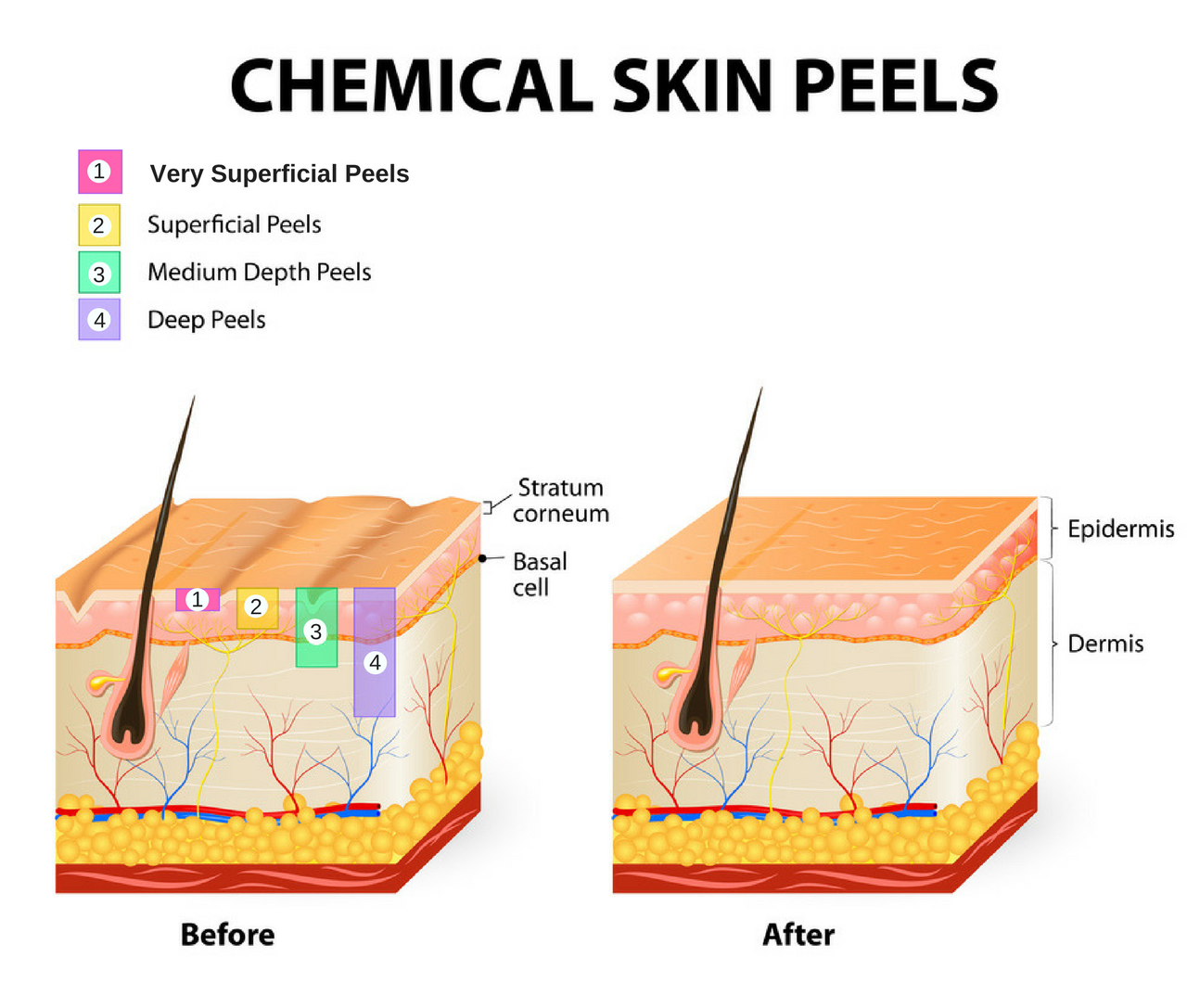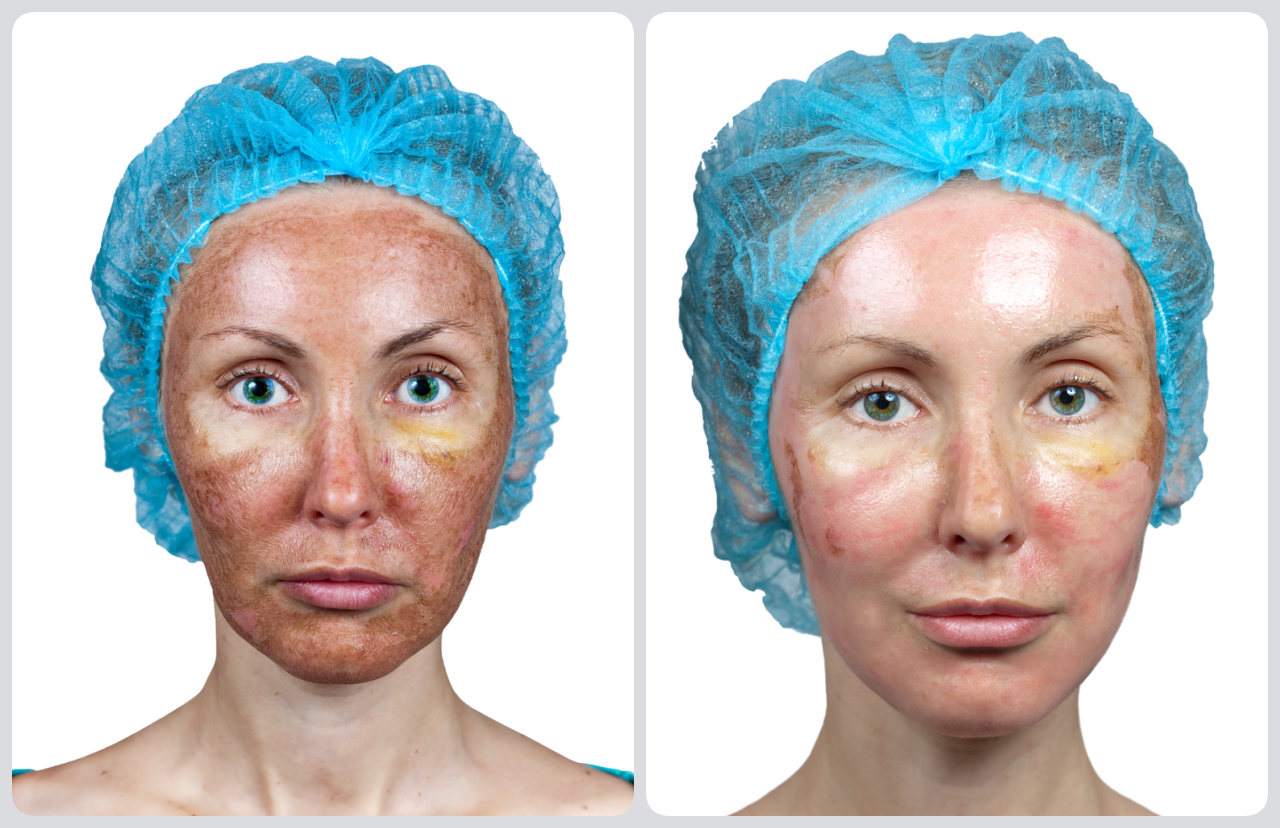Chemical peeling involves the application of a chemical solution to the surface of the skin to produce the careful removal of its outer layers.
Peeling (exfoliation) of the skin is a natural process. Chemical peeling is an accelerated form of exfoliation induced by the use of a chemical agent. It’s can be used on face or specific areas to remove the dead skin cells, most damaged skin layers, allowing newer, healthier skin to emerge.
Levels of peels:
- Very superficial peels (exfoliation): these peels thin or remove the stratum corneum and do not create a wound below the stratum granulosum
- Superficial peels (epidermal): these peels create necrosis of part or all of the epidermis, anywhere from the stratum granulosum of the basal cell layer.
- Medium peels (papillary dermal): these peels create necrosis of the epidermis and part or all of the papillary dermis
- Deep peels (reticular dermis): these peels create necrosis of the epidermis and papillary dermis that extends into the reticular dermis

TYPES OF PEELS:
1. Salicylic acid (BHA) – Salicylic Acid comes from the bark of the willow tree, Salicylic Acid is also aspirin based Salicylic Acid is a Beta Hydroxy Acid and much gentler on the skin compared to Alpha Hydroxy Acid and causes less irritation. Can treat only small areas and be aware of the client has ant allergies to aspirin. Skin conditions it can treat are acne, psoriasis, dandruff and acne-prone skin. It effectively exfoliates and penetrates oil-filled pores and exfoliates the dead skin cells that build up inside, thereby reducing irritation and inflammation.
Benefits of BHAs:
- Helps break down blackheads and whiteheads.
- Unclog pores and prevent future breakouts.
- Can also be used on dry sensitive skin, along with ageing skin to an even appearance of tone and texture and allows for the growth of new skin.
2. Alpha hydroxy acid (AHA) Comes from a variety of fruit acids such as Glycolic, Citric, Lactic, Malic and Tartaric and each acid is derived from a different source. While all AHAs share a similar molecular structure, their differences become relevant as to how each is used. They can be used to achieve these goals over a period of time or in quick sessions.
Benefits of AHAs:
- Rough dry skin, by attracting moisture to the skin, helps to smooth the skin
- Aging enhances the effects of other skin rejuvenation treatments
- Acne remove the dead skin cells and unclogged the pores
- Sun damage, even texture, complexion of skin and reverse some of the effects of UV damage
AHAs help disintegrate the “glue” that hold dead, dry skin cells to the surface of the skin. By doing so, the epidermis is exfoliated leaving a silky texture. Removal of this external barrier enables easier, deeper penetration of other skin treatments as well.
List of Alpha Hydroxy Acids
- GLYCOLIC ACID This is certainly the most commonly used member of the AHA family for skin rejuvenation. Glycolic acid comes from sugar cane and can also be made synthetically. Its small molecular size allows it to penetrate the skin more easily, which contributes to its effectiveness. Smallest in molecular size.
- CITRIC ACID Largest AHA is molecular size. Exfoliation is not its main function and realistically should not be considered an exfoliator, but Citric Acid or Vitamin C has many benefits as an antioxidant as well as help stimulate collagen production within the dermis.
- LACTIC ACID Lactic acid comes from sour milk. Dermatologists originally used it as a skin rejuvenation AHA until studies showed that glycolic acid gave superior results for this use. Is an ideal skin softener, lactic acid is frequently used by dermatologists to cut through thick, rough skin
- TARTARIC ACID This is actually a by-product of the fermentation process that takes place while making wine. Second, largest AHA is molecular size. Generally used in combination with AHA’s.
- MALIC ACID This is a fruit-derived AHA usually made from unripe apples and green grapes. It has little effect as a skin treatment, although generally used in anti-aging and in combination with other AHA’s.
3. Retinoic acid (Retin A) is also known as tretinoin. Derived from Vitamin A. Retinoic acid controls the differentiation program of epithelial cells. Well used in anti-aging treatments. Helps prevent degradation of sun damaged skin cells, increase hyaluronic acid levels in the skin and stimulates fibroblast growth.Also, treat an acne due to the keratinization of this disorder.
4. Jessner peel is a combined 14% salicylic acid, 14% lactic acid, and 14% resorcinol in an ethanol base. It is Superficial peeling, great for exfoliating and acne care. Modified Jessner peel is the same 3 base acids, but they can be in smaller percentages or other ingredients are included Resorcinol Peel.
5. Resorcinol is a chemical based peel Resorcinol is used to treat acne, eczema and psoriasis and seborrheic dermatitis among other skin conditions. It is also used to treat corns, calluses, and warts It is sometimes combined with other acne medications, It is also used to treat corns, calluses, and warts It is sometimes combined with other acne medications, usually, sulphur, and rarely stands alone, helps break down hard, rough skin, which is good at breaking down existing blackheads and whiteheads. Works by helping to remove hard, scaly, or roughened skin.
Mostly available under a doctor’s prescription
6. TCA peel
A TCA peel is often used for the treatment of wrinkles, pigmentary changes, and skin blemishes. Many patients benefit from having TCA applied on the face, neck, and other areas that have been exposed to the sun. For spot peeling of limited areas, including around the mouth or eyes, TCA peels are often preferred because they have a less bleaching effect than solutions containing phenol, another popular peeling agent. For that reason, some medical providers have found TCA to be effective in treating darker-skinned patients.
Milder TCA peels can be frequently repeated to achieve cumulative effects, or TCA can be used to achieve a medium or even a deep peel, depending on the acid concentration and manner of application.
7. Phenol Peel
A phenol, also known as carbolic acid, a peel is sometimes recommended for treating particularly rough and/or sun-damaged facial skin. Phenol is effective in reducing the appearance of wrinkles ranging from fine lines to deeper creases. It can correct pigmentary problems, including blotchiness or age-related brown spots, and may be used to treat precancerous skin conditions.
Phenol is particularly helpful in minimizing the vertical lines that form around the mouth due to ageing. The disadvantage of phenol for spot peeling of limited areas is that it often has a bleaching effect. Unlike TCA peels, phenol cannot be used on your neck or areas. Variations in a phenol peel formula, creating a “buffered” or milder solution, may allow for greater flexibility in its use.

How is a chemical peel performed?
For light-to-medium skin peels (TCA and AHAs), your skin therapist will select the best chemical or chemical mix for your skin. The solution is then applied with a sponge, cotton pad, cotton swab, or brush, avoiding the eyes, brows and lips.
Various concentrations of an AHA may be applied weekly or at longer intervals to obtain the best result. A TCA peel is stronger and has a greater depth compared to AHAs.
A full-face deep chemical peel takes one to two hours, with more limited procedures, like treating the wrinkles above the lip, will generally take less than a half-hour. A solution is applied to the area being treated, avoiding the eyes, brows, and lips. There is a slight burning sensation, but it should be minimal since the solution also acts as an anesthetic.
After the peel solution has worked on the skin, it is neutralized with water. Approximately an hour later, a thick coating of petroleum jelly is layered over the patient’s face, covering the protective crust which rapidly develops over the area. This stays in place for one to two days. In an alternative technique, the patient’s face is covered by a “mask,” or strips of adhesive tape, with openings for the eyes and mouth, which is particularly effective in cases of severe wrinkling.
Chemical peels can treat the following skin conditions:
– Skin laxity in your lower eyelid area
– Vertical wrinkles around the mouth, forehead and crows feet
– Brown spots or blotchy skin coloring or uneven tone and sun-damaged skin
– Some precancerous skin growths
– Acne or acne scar or chicken pox scars
– Superficial facial scars from a past injury
Certain other characteristics of your skin, such as its thickness and texture, may influence whether you are a good candidate for the chemical peel. Contact us to determine which peel is best for you. Call 029361 4441
Want new articles before they get published?
Subscribe to our Awesome Newsletter.

